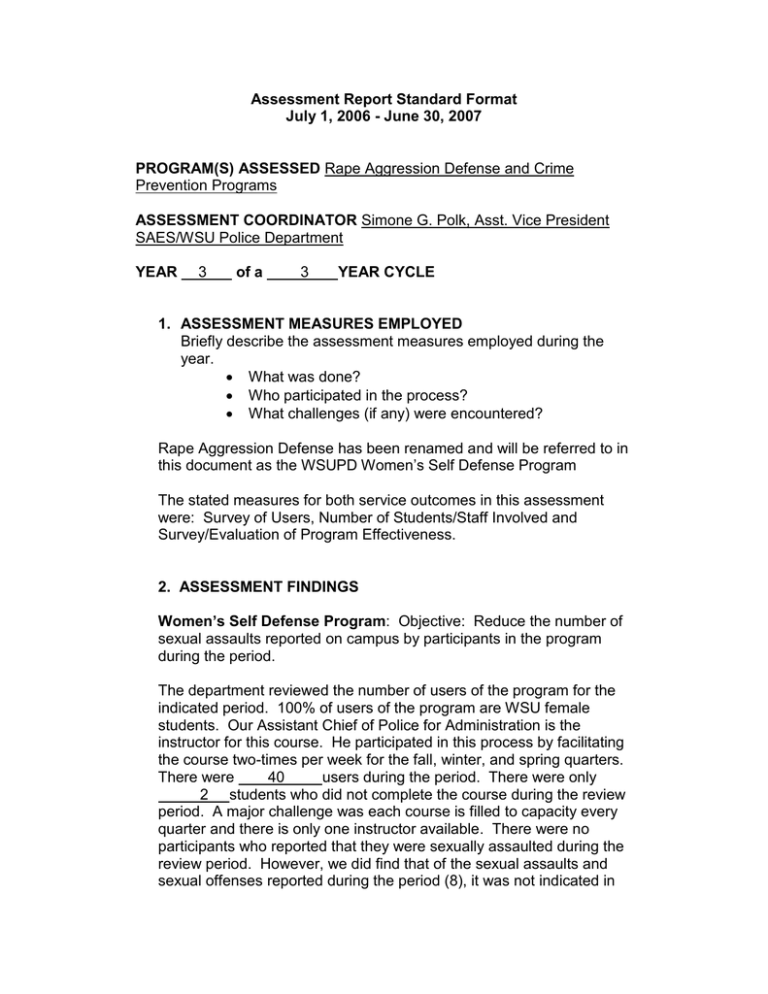
Assessment Report Standard Format
July 1, 2006 - June 30, 2007
PROGRAM(S) ASSESSED Rape Aggression Defense and Crime
Prevention Programs
ASSESSMENT COORDINATOR Simone G. Polk, Asst. Vice President
SAES/WSU Police Department
YEAR
3
of a
3
YEAR CYCLE
1. ASSESSMENT MEASURES EMPLOYED
Briefly describe the assessment measures employed during the
year.
What was done?
Who participated in the process?
What challenges (if any) were encountered?
Rape Aggression Defense has been renamed and will be referred to in
this document as the WSUPD Women’s Self Defense Program
The stated measures for both service outcomes in this assessment
were: Survey of Users, Number of Students/Staff Involved and
Survey/Evaluation of Program Effectiveness.
2. ASSESSMENT FINDINGS
Women’s Self Defense Program: Objective: Reduce the number of
sexual assaults reported on campus by participants in the program
during the period.
The department reviewed the number of users of the program for the
indicated period. 100% of users of the program are WSU female
students. Our Assistant Chief of Police for Administration is the
instructor for this course. He participated in this process by facilitating
the course two-times per week for the fall, winter, and spring quarters.
There were
40
users during the period. There were only
2 students who did not complete the course during the review
period. A major challenge was each course is filled to capacity every
quarter and there is only one instructor available. There were no
participants who reported that they were sexually assaulted during the
review period. However, we did find that of the sexual assaults and
sexual offenses reported during the period (8), it was not indicated in
the criminal incident report that the victims had participated in a
program. In two of these cases, the victims were not affiliated with
WSU.
After reviewing the documented surveys of the users, we learned that
the Program was effective in the following ways:
1. “The instructor did a good job of making sure we all understood the
moves and why/how they worked. He was very respectful to
everyone.”
2. “The instructor was a wonderful teacher who is very good at what
he does. I loved this class.”
3. “Every time I had a question or concern, he made it a point to make
sure my question was answered and I felt reassured.”
4. “I feel very motivated after taking this course; I also feel very
confident about being put in such situations.”
5. “This course was very helpful and I’m so glad I took this course; I
feel confident and I feel I will be able to defend myself in any situation.”
6. “He did a good job including all of us and our abilities; Techniques
were well-explained and demonstrated.”
7. “He did an awesome job; I learned a lot and I definitely feel a lot
better if the situation was to arise; definitely a lot more confident.”
8. “I really liked the simulation; lots of fun; I want to do it again.”
9. “He told us what guys would try to do and what we could do to stop
them; I think every girl should take this class; I learned a lot.”
10. “I never had any idea how to defend myself, now I feel sure that I
can at least put up a good fight.”
Crime Prevention Programs: Objective: Reduce the number of
opportunity thefts during the period.
Providing crime prevention programming to community members is
vital. For example, it is expected that the number of opportunity thefts
reported will be reduced if community members learn crime prevention
measures that will positively affect the security of their personal
property while on campus. The number of thefts reported during the
period was
170
. This number was 16 less than the
previous period. Many of these thefts were created by community
members leaving property unattended or unsecured, thus “opportunity
thefts” were created.
After reviewing the number and type of programs delivered during the
period (10 to 20 programs), we learned that the Programs were
effective in the following ways:
1. Educating students regarding overall effective safety measures
2. Educating students regarding alcohol abuse prevention
3. Educating faculty and staff regarding overall effective safety
measures.
3. PROGRAM IMPROVEMENTS
Women’s Self Defense Program: Planned changes may include
adding an additional instructor so that an additional course can be
offered each quarter. Additional marketing through University CollegeSOAR, the Women’s Center, and an email flyer are methods that
should be explored to encourage greater participation in the program.
In the past, demonstrations of the program curriculum have been very
effective in encouraging participation and should occur during the
spring as a way of encouraging female students to sign up for the fall
course. We may also consider a “short course” for Community
Advisors in Residence Services so that we can target this group of
service providers.
Crime Prevention Programs: Theft and personal property crimes
numbered 170 for the period. Reduction in crime prevails over
“interest” in programs. For example, community groups may request
programs that are “exciting”, such as alcohol and drug abuse, personal
protection/safety, while they do not generally request theft prevention
safety. A suggested program improvement could be the development
of theft prevention presentations. These programs could be utilized in
different venues that are also interactive; i.e. Q/A, simulations,
available on-line, disseminated via email, and allowing for user
participation in creation and implementation of action steps for safety
of their property at work and at home.
4. ASSESSMENT PLAN COMPLIANCE
No deviations from the plan noted.
5. NEW ASSESSMENT DEVELOPMENTS
None noted.




